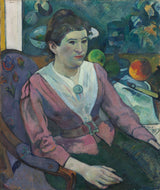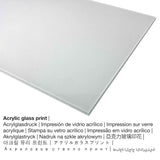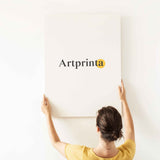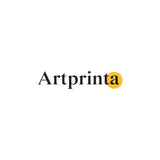Paul Gauguin, 1890 - Woman in front of a Still Life by Cézanne - fine art print
Tax included. Shipping calculated at checkout.
Art product background information
The modern art masterpiece was created by the male French painter Paul Gauguin. The artpiece had the following size: 65,3 × 54,9 cm (25 11/16 × 21 5/8 in). Oil on linen canvas was applied by the French artist as the technique for the painting. The original painting has the following text as inscrption: inscribed 6" above right corner: P. Go. / 90. Besides, the piece of art is in the the Art Institute Chicago's collection, which is one of the world’s great art museums, housing a collection that spans centuries and the globe. With courtesy of Art Institute Chicago (licensed - public domain). The creditline of the artpiece is: Joseph Winterbotham Collection. Further, the alignment of the digital reproduction is portrait and has a ratio of 1 : 1.2, which means that the length is 20% shorter than the width. The painter, sculptor, graphic artist Paul Gauguin was a European artist from France, whose style can be attributed mainly to Impressionism. The Impressionist artist lived for a total of 55 years and was born in the year 1848 in Paris, Ile-de-France, France and died in the year 1903 in Atuona, French Polynesia.
Fine art print materials which you can select:
The product dropdown menu ofers you the opportunity to select the material and sizeaccording to your personal preferences. You can choose your your favorite size and material among the following options:
- The canvas print: The printed canvas, not to be mistaken with a painting on a canvas, is a digital replica printed on an industrial printing machine. It makes the particular look of three-dimensionality. A canvas print has the advantage of being relatively low in weight. That means, it is quite simple to hang up the Canvas print without the use of any wall-mounts. Hence, canvas prints are suited for any type of wall.
- Poster (canvas material): The Artprinta poster print is a UV printed sheet of flat canvas with a nice surface texture. The printed poster is qualified for framing the art print with a custom-made frame. Please note, that depending on the size of the canvas poster print we add a white margin of approximately 2-6cm around the print motif, which facilitates the framing.
- Aluminium dibond print: An Aluminium Dibond print is a print material with an outstanding depth. The bright sections of the original work of art shimmer with a silk gloss, however without the glare.
- Glossy acrylic glass print (with real glass coating): The acrylic glass print, often described as a plexiglass print, transforms your favorite original work of art into great décor. Your favorite artwork is being made with the help of state-of-the-art UV direct printing technology. The acrylic glass protects your selected art replica against sunlight and external influences for many decades.
Legal disclaimer: We try to describe our products as accurate as possible and to demonstrate them visually. Although, the tone of the print products and the print result can vary somehwat from the representation on your device's monitor. Depending on the screen settings and the nature of the surface, colors might not be printed as realisitcally as the digital version shown here. Bearing in mind that our fine art prints are printed and processed by hand, there might also be slight discrepancies in the size and exact position of the motif.
About this product
| Product categorization: | art reproduction |
| Reproduction: | digital reproduction |
| Production method: | UV print / digital printing |
| Provenance: | manufactured in Germany |
| Type of stock: | on demand production |
| Intended usage: | wall decoration, art collection (reproductions) |
| Artwork alignment: | portrait alignment |
| Aspect ratio: | length : width - 1 : 1.2 |
| Side ratio meaning: | the length is 20% shorter than the width |
| Available product fabrics: | poster print (canvas paper), acrylic glass print (with real glass coating), metal print (aluminium dibond), canvas print |
| Canvas on stretcher frame (canvas print) sizes: | 50x60cm - 20x24", 100x120cm - 39x47", 150x180cm - 59x71" |
| Acrylic glass print (with real glass coating) size options: | 50x60cm - 20x24", 100x120cm - 39x47", 150x180cm - 59x71" |
| Poster print (canvas paper) sizes: | 50x60cm - 20x24", 100x120cm - 39x47" |
| Aluminium dibond print: | 50x60cm - 20x24", 100x120cm - 39x47" |
| Art print framing: | no frame |
Details on the original work of art
| Painting title: | "Woman in front of a Still Life by Cézanne" |
| Artwork classification: | painting |
| Umbrella term: | modern art |
| Period: | 19th century |
| Created: | 1890 |
| Approximate age of artwork: | more than 130 years old |
| Original medium of artwork: | oil on linen canvas |
| Original artwork dimensions: | 65,3 × 54,9 cm (25 11/16 × 21 5/8 in) |
| Signature on artpiece: | inscribed 6" above right corner: P. Go. / 90 |
| Museum / collection: | Art Institute Chicago |
| Museum location: | Chicago, Illinois, United States of America |
| Website: | www.artic.edu |
| License type of artwork: | public domain |
| Courtesy of: | Art Institute Chicago |
| Creditline: | Joseph Winterbotham Collection |
Artist table
| Name of the artist: | Paul Gauguin |
| Aliases: | Paul Gaugin, Gaugin Paul, גוגן פול, Paul Gauguin, P. gaugin, Gauguin Paul, gauguin p., Gauguin, Eugene-Henri Gauguin, Gauguin Eugène Henri Paul, p. gauguin, Gauguin Pablo, Kao-keng, Gogen Polʹ, Gauguin Eugène-Henri-Paul, gauguin paul |
| Gender: | male |
| Nationality: | French |
| Jobs: | sculptor, painter, graphic artist |
| Country: | France |
| Artist category: | modern artist |
| Art styles: | Impressionism |
| Age at death: | 55 years |
| Year of birth: | 1848 |
| Place of birth: | Paris, Ile-de-France, France |
| Year died: | 1903 |
| Place of death: | Atuona, French Polynesia |
This text is protected by copyright © - Artprinta.com (Artprinta)
Artwork description as provided by Art Institute Chicago (© - by Art Institute Chicago - www.artic.edu)
In this work, an unidentified woman sits in front of Paul Cézanne’s 1879–80 Still Life with Fruit Dish, now at the Museum of Modern Art, New York. The painting was part of Paul Gauguin’s own collection, and here he proprietarily signed his name over its white frame. Of the five or six Cézannes that he acquired while still a banker, this was the one he claimed he would never part with, “except in a case of direst necessity.” (He would eventually sell it to pay for medical treatment in Tahiti.) Although the version in this painting is nearly to scale with the original, it is more a translation than a copy, with rhythmical arabesques that are characteristic of Gauguin’s painting style rather than Cézanne’s.














